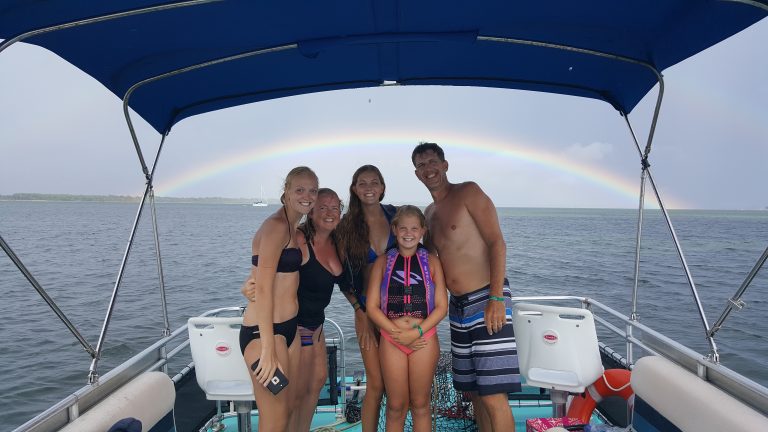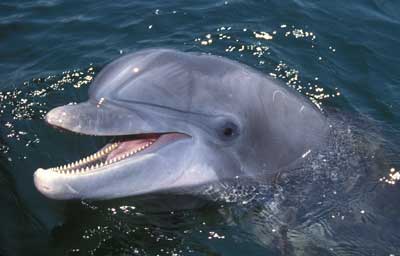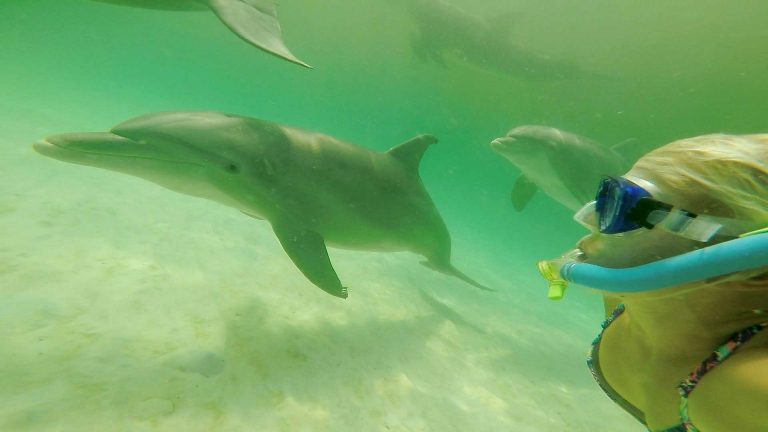Dear WaterPlanet Folks,
Last week, I fished a couple of days in FWB off of Oklaoosa Island Pier. My wife Nancy and I caught Spanish mackeral, hardtails, and lots of smaller fish. I have learned from Nancy that the “smaller fish” that we have always used for bait actually taste better than the larger fish like King mackeral, cobia, etc.
This time, I made an interesting observation while fishing off the pier. In the 1960’s I used to fish a LOT off of old Wayside Pier as well as Crystal Beach Pier, Navarre Pier, Pensacola Pier, and Panama City Beach Piers. We occasionaly had bottle-nosed dolphins swim near the pier, but they NEVER EVER even looked at a hooked bait or live fish that we sometimes through at them. I remember late one evening I cast at some tarpon just before dark and a porpoise actually swam underneath my bait and almost mouthed it. I almost had a heart attack. I think it was really dark and he could not see the hook and line until he got really close but he never actually touched the bait.
In the early 90’s, I came back and fished on Okaloosa Island Pier (it used to be Wayside Pier) and was surprised to see that porpoises would now sometimes grab a hooked fish when someone was reeling it in. They never got hooked, but they were smart enough to get the fish. They had learned to get a free dinner. It was a sporadic thing.
The first evening we fished last week, a family of about 5 porpoises came around the pier. They would actually swim under the pier and were obviously rounding up spanish mackeral and hardtails. They never actually chased after them, they just herded them up within casting distance of people fishing on the pier. The man fishing next to me hooked a spanish mackeral and a porpoise grabbed his fish and swam slowly away from the pier. You could see it swimming and surfacing leasurely a couple of hundred yards away. The drag on the man’s reel was whining away and he was saying that the porpoise was going to strip off all of his line. Several times the porpoise let go of the line and it allowed the man to reel in 50 or so yards of line before grabbing hold of the fish again. This went on for about 10 minutes then the porpoise let go of the fish and the man reeled in the head of the fish. Another man from Panama City was talking to me and watching this behavior and he was amazed. He fished a lot off Panama City piers and he had never seen a porpoise grab a fish on a line.
A few minutes later while the porpoises were still swimming around the pier, I hooked a spanish mackeral. I saw a porpoise coming for it so I put my hands over my head and reeled as fast as I could. The spanish mackeral was skiing across the top of the water when the porpoise turned leisurely upside down and grabbed my fish. It swam slowing away from the pier to a position in the surf about 200 yards from the pier and several times it would release the fish, I would reel like a mad man and after 50 or 75 yards, the porpoise would grab the fish again and swim slowly away. It never went far enough away to strip all the line off my reel, but it could have easily done so. Somehow this porpoise knew how far he could go without getting all my line; maybe through years of practice? After a few minutes, the porpoise got the fish off the line and I reeled my lure back in. The lure had two treble hooks and they were not bent at all so the porpoise was never actually hooked.
Nancy was fishing with 5 small hooks on her line directly under the pier for smaller fish. At one point she was reeling in and she started squealing because a porpoise had her line. I leaned over the rail and looked down at the porpoise with his head cocked to the side looking up at me. He was nibbling gently on one of Nancy’s 4 inch long fish and smiling up at us. Her line had stopped coming up and the other 4 fish were dangling about 5 feet above the porpoise’s head. The porpoise sat patiently looking at the fish and I guess he thought I would lower them to him so he could eat the rest, but instead I pulled the line up by hand and he swam away.
The next evening, a north wind was blowing which blows the fish off the beach and makes for lousy fishing. We went fishing anyway because we had nothing else to do. Their were no fish around the pier. A couple of hours before sundown, I looked a mile or so down the beach and I could see a family of porpoises moving very slowly and quietly towards the pier. I could tell they were echo-locating trying to find schools of fish. They came slowly around the pier, but did not stay because there were no fish. During the next hour or so I watched them move slowly up and down the beach looking for schools of fish, but eventually they moved on. There were no schools of fish so they couldn’t play their game with the fishermen that evening.
These darn things are really smart. I talked to other fish-heads on the pier to ask if the porpoises grabbed fish at any of the other piers in the area. I explained I had been pier fishing their since the ’60’s and this used to never happen so it was definitely a learned behaviour. Of the half dozen or so piers on the hundred mile stretch of coastline between Pensacola and Panama City, this behavior has only been seen at Okaloosa Island Pier. The first day when there were lots of fish, it was obvious to me the porpoises would herd the fish to the pier where fishermen could hook them and the porpoises could have an easy dinner by taking them off the lines and also have a bit of play. It also occurred to me that the porpoises were allowing humans to play in the game because they let you catch some fish, took a few other fish, only swam a certain distance when they grabbed your fish, and they kept letting go of the fish and catching it again presumably so humans could have some fun in the game too. The porpoises KNEW what humans were doing (having fun catching fish) and they made up the rules of the game so we could all play the game and have fun. They made sure they did not strip all of your fishing line (why would a porpoise want 300-400 yards of fishing line in the water?) and they made sure they didn’t swim away too fast with your fish so they wouldn’t ruin your fishing reel or break your rod. They wanted the humans to enjoy the game too so they kept releasing the fish only to catch them again a few seconds later.
There was a juvenile porpoise in this family group so I guess they teach their babies how to play this fun game too.
Another curious thing is that the Gulfarium (yes, it’s still there) is right next to the pier and they have “Trained” porpoise acts in there where humans and dolphins interact and the porpoises are rewarded with fish. People come and watch the behavior and laugh and applaud (this happens on the pier, too). Now here is where it gets wierd:
I know the Gulfarium has water intake pipes and discharge pipes that extend a ways into the gulf off the beach. I grew up with Randy Siebenaur and his daddy owned and built the Gulfarium 60 years ago, so I know how it works. Sound travels about 5 times faster underwater and Blue Whale songs can be heard 500 miles away by other Blue Whales. What if somehow, the porpoises in the Gulfarium can sometimes communicate with the wild population of porpoises right off the beach playing in the surf. It sounds sort of far fetched, but how else could you explain this learned behavior that only occurs at the pier directly in front of the Gulfarium?
Anyway, I know these fascinating mammals are capable of remarkable things. I just thought I should bring this type of behavior to someone’s attention. Does anyone at your facility have any comments about this?
Thank you.
Bill Lovelock
Clinical Laboratory Scientist
US Department of State
Washington, DC
Hi Bill,
I love your story and especially the way you write. Thank you for sharing.
You have indeed observed interesting and entertaining wild dolphin behavior.
I started Water Planet in 1994 in Panama City and I have been on the water between March and November ever since almost every day. I have witnessed and documented the acquired begging behavior and the provisioning by humans associated with it. Before I comment on your observations made at the Okaloosa Island Pier, I want to talk about my experience of the “rise and fall” of dolphin feeding in Panama City. As you probably know, feeding wild dolphins has been one of the favorite weekend pass time for local boaters since the 80’s or so. Besides that, Sports Fishing size limits and catch and release, together with commercial fishing by-catch have through the years contributed in reinforcing the begging behavior. The lack of enforcement and the grey area concerning feeding wild dolphins in the Marine Mammal Protection Act of 1972 have allowed the provisioning to escalate even with dolphin tour boats until I believe 1990 when the MMPA was amended to include provisioning as harassment. Unfortunately, the continuing lack of enforcement in the Panama City area has allowed professional dolphin tour operators to proliferate and to develop a whole industry around these habituated animals. By continuously feeding them, the tour guides have maintained this food-based dependency to provide an adrenaline filled SeaWorld-type experience to their customers. The closer the interaction, the bigger the tip. Unfortunately, several dolphins carry propeller or fishing gear entanglement scars to prove that point. Since the dolphins are very social and inquisitive, they come too close for their own good. Last spring in Orange Beach, a dolphin was sighted swimming around with a screwdriver in his head. He was found dead on the beach the next morning. How is it that the animal came close enough to someone as to allow that person to stab him? He must have been habituated to close interactions with people and boats and lost his sense of fear altogether. Many of these habituated animals get away without being injured or killed and after years of repeated contact with boats and people, they learn how to take advantage of us. Since we have offered “swim with” programs since 1994, I have had the opportunity to observe wild dolphin behavior during their interactions with humans and I must say that I do not stop being amazed by their intelligence, playfulness and even (it seems) sense of humor. I oftentimes see them mimicking swimmers or tricking them. I would say that about 10% of the local population is habituated and will spend considerable amount of time soliciting food from boats, swimmers and people fishing from piers. No later than last week, I was fishing off of the St. Andrew State Park Pier with my kids and there was one of the well known “beggar”, hanging out below. Every time someone was catching a Ladyfish or a Spanish Mackerel, Chester was picking it off the hook. The same thing happens with charter fishing boats bottom fishing on the artificial reefs or trolling on the sandbars. The dolphins follow them out and eat most of the fish before it reaches the boat. They do it with such dexterity that most of the time, they do not get snagged in the process. I have lost more then one fish to dolphins myself. They can recognize the captain who feed them and should the captain one day drive a different boat, they will go to him rather than to the boat he usually drives. Last year was the worst since the early 90’s in terms of number of people/captains/guides feeding and petting dolphins. It was also the year I finally released the program I had been working on for years: BADTOFEED (see links below).
In conclusion and in my opinion, the behaviors you have been observing from the Okaloosa Island Pier are the result of decades of interaction between humans and wild dolphins on the Emerald Coast. Based on local studies, some dolphins are known to travel between the St. Joe Bay and the Choctawhatchee Bay and I would not be surprised if they are reaching to your area as well. Allot of information is transmitted from mother to calf. Some of this information is about swimmers, boats, fishing lines, baited hooks, etc. Information is also passed along to other group members.
Once again, thank you for sharing your experience, which I will keep on file for future references.
Do not hesitate to send along more of your observations.
Best regards
Denis Richard
Water Planet




